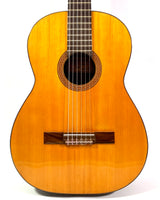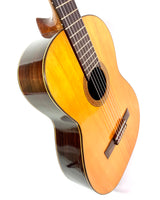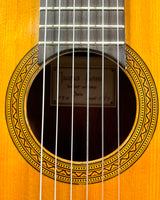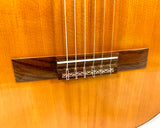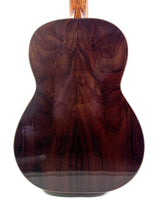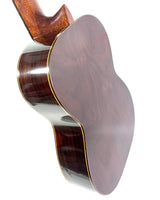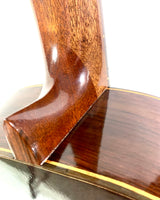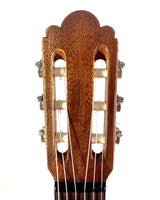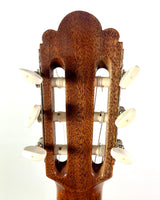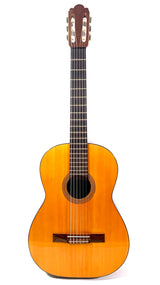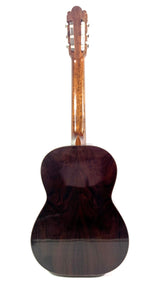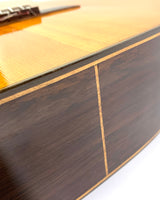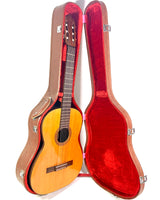Jacques Favino
Jacques Favino 5A from 1973
Jacques Favino was born in 1920 in Trecate in northern Italy and arrived in Paris in 1923.

Jacques Favino in his workshop
(Source: www.guitaremag.com)
He began his professional life as a carpenter before moving into mechanics.
Then, thanks to his brother-in-law, it was after the end of the Second World War, in 1945, that he began working in the Busato workshop where he notably met Jean Chauvet (1920-1981) with whom he became close friends. 'friendship.
And it is the latter who will train him in violin construction and give him a taste for violin making.
They set up on their own very shortly after, in 1946, and it was during these years when they shared a workshop on rue des Moines, after meeting a gypsy guitarist, that Favino decided to start making guitars. guitars.
And it was in 1956, after the separation of the Chauvet-Favino duo, that Favino specialized in the guitar.
Indeed, following an argument, the two friends separated and agreed on the fact that Favino would no longer play violin and Chauvet, no longer guitars.
Favino produced many guitars for department stores in Paris, such as Major Conn, Lutherie Centrale, Masse pas Cher, and Pierre Beuscher.
And it is thanks to the latter, having bought the tools and spare parts from the Selmer guitar workshop after their production ceased in 1952, that Jacques Favino set about manufacturing his first gypsy guitars.
Indeed, at Beuscher's request, he will "build" around twenty gypsy guitars with original parts from Selmer stock, he will use the necks, tailpieces and tuners from stock, but will entirely manufacture the body himself. even on a slightly larger size, with a dam very close to that of the Selmer.
Subsequently, during the 1960s, faced with competition from Japanese guitars, he gradually reduced his production for resellers and exclusively manufactured on demand.
He will thus manufacture for some of the greatest artists such as Antoine Bonnelli , guitarist of Tino Rossi, who will allow him to develop the manufacture of gypsy guitars, but also Georges Brassens, Enrico Macias, Henri Salvador, Marie-José Neuville, Barthélémy Rosso, Maxime Le Forestier, Joseph Reinhardt, Jacques Montagne, Maurice Ferret, the Ferré brothers over two generations, but also Raphaël Faÿs, Biréli Lagrène, Mondine Reinhardt, Patrick Saussois, Serge Camps, Angelo Debarre, Moreno Winsterstein, the Lulu Reinhardt, Häns'che Weïss, and the Rosenberg Trio to name but a few.
In addition to gypsy guitars, he made numerous instruments in his workshop in the 18th arrondissement of Paris at 9 Rue Clignancourt, such as twelve-string folk guitars, arch-top guitars, basses and even classical guitars.
He is also famous, among other things, for the classical guitar model he created for Georges Brassens in 1955.

Georges Brassens in 1961 with his guitar model made by Jacques Favino.
(Source: www.benoit-de-bretagne.com)
Thus the 5A model appeared, which is a classic guitar model, from the 1950s-1960s as evidenced by this advertising leaflet from those years:

(Source: Veillon, P., & Legrand, A. (2021). Favino: History of luthiers Jacques & Jean-Pierre favino . Pass'guitar.)
Here is a very beautiful 5A model of classical guitar made by Jacques Favino in 1973.
Technical characteristics :
- Top: Spruce
- Back: Rosewood
- Sides: Rosewood
- Neck: Mahogany
- Fingerboard: Rosewood
- Width at nut: 52 mm
- Radius: 20"
- Frets: 19 frets
- Scale: 25.75" (655 mm)
- Profile: Slim C
- Hardware: Chrome
- Manufacturing country : France paris
- Year: 1973
- Finish: Natural
- Decorations: Rosette in fine marquetry / upper part of the bridge inlaid with fine marquetry / Ebony-maple-ebony binding on the edge of the table / Ebony binding on the bottom edge / Maple binding on the edge of the sides
- Details: Some slight signs of wear, normal given its age
The guitar is in very good condition.
Fully tuned, it is very easy to play.
It has good projection, very good sound balance and nice harmonics.
Delivered in its original case.

